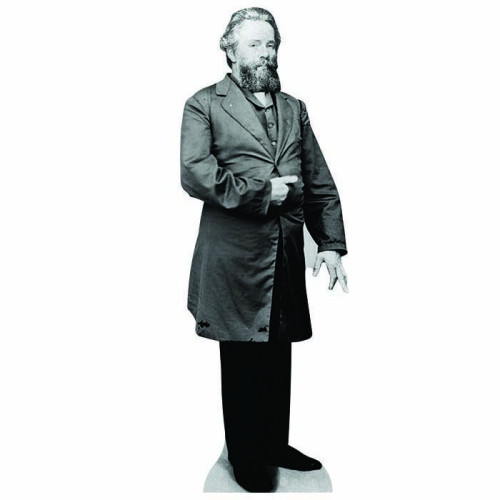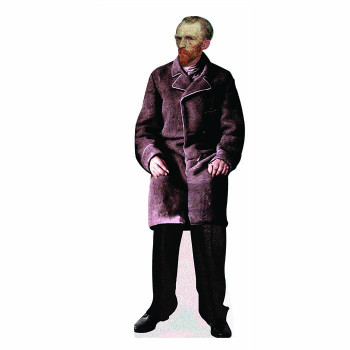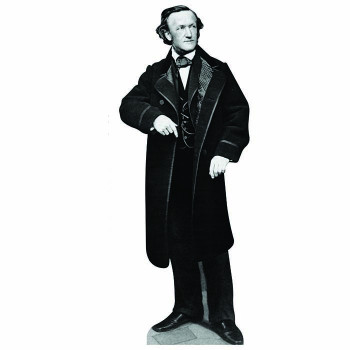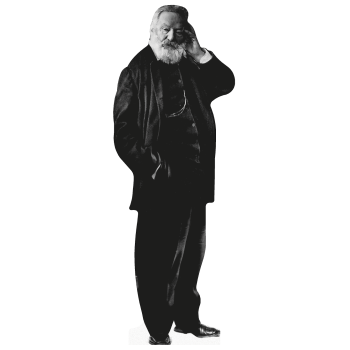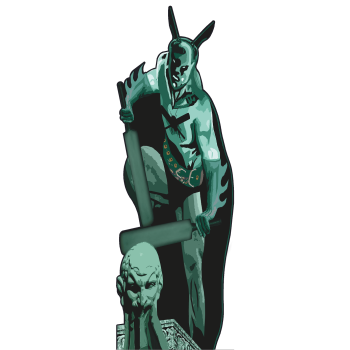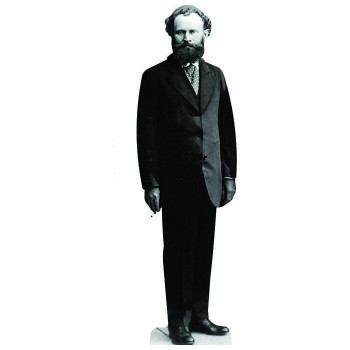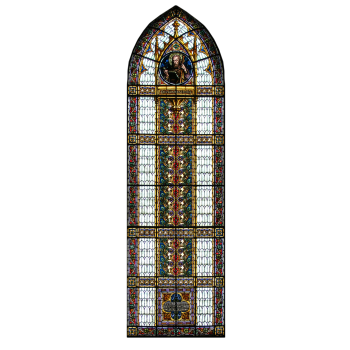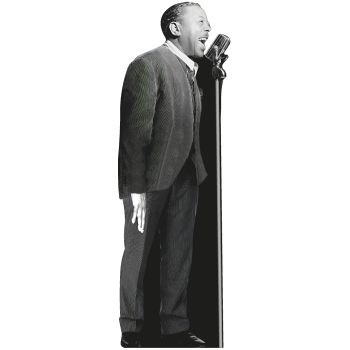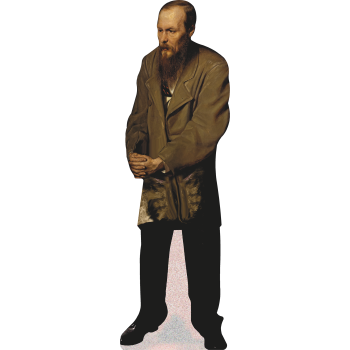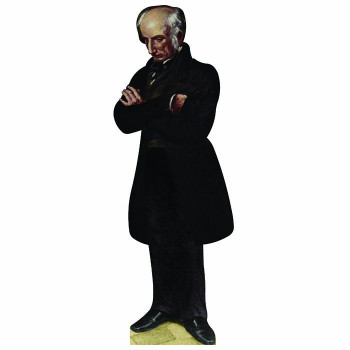HERMAN MELVILLE CARDBOARD CUTOUT
-
$0.00
Available Options
66 x 23 inches. Our cardboard cutout of Herman Melville. All cardboard cutouts come folded and have an easel attached to the back to be self-standing. Items are printed and produced to order. Printing and processing takes up to 5 business days plus shipping time.
Introduction to Herman Melville
Celebrate the legacy of one of America's greatest literary figures with our lifesize cardboard cutout of Herman Melville. Perfect for literary displays, educational events, or as an inspiring addition to your home or office, this cutout captures the contemplative and adventurous presence of Herman Melville, reflecting his profound impact on American literature and his contributions to the literary canon.
Background of Herman Melville
Herman Melville was born on August 1, 1819, in New York City. The third of eight children, Melville experienced financial instability early in life after the death of his father in 1832. These hardships forced him to leave school and work various jobs, including as a clerk, teacher, and sailor. His seafaring adventures provided rich material for his future literary works.
In 1841, Melville embarked on a whaling voyage aboard the Acushnet, which significantly influenced his writing. After a series of maritime escapades, including being held captive by Typee natives in the Marquesas Islands, Melville returned to the United States and began his writing career.
Melville's first novels, "Typee" (1846) and "Omoo" (1847), were based on his Polynesian adventures and brought him initial success. However, his literary fame waned with the publication of more ambitious works like "Mardi" (1849) and "Redburn" (1849), which received mixed reviews.
In 1851, Melville published his masterpiece, "Moby-Dick." Initially met with critical ambivalence, the novel's complex narrative and profound themes eventually earned it recognition as one of the greatest works of American literature. "Moby-Dick" explores themes of obsession, revenge, and the human condition, centered around the monomaniacal Captain Ahab's pursuit of the titular white whale.
Melville's later works, including "Pierre" (1852), "The Confidence-Man" (1857), and the posthumously published novella "Billy Budd" (1924), continued to explore dark and philosophical themes but did not achieve the same level of acclaim during his lifetime.
Financial struggles and dwindling readership led Melville to work as a customs inspector in New York City for nearly two decades. He continued writing poetry and fiction in his spare time until his death on September 28, 1891. It was only after his death that Melville's literary genius was fully recognized, and his works were re-evaluated and celebrated.
Cultural Impact of Herman Melville
Herman Melville's impact on American literature is profound and enduring. "Moby-Dick" stands as a towering achievement in the literary canon, renowned for its narrative complexity, symbolic depth, and exploration of existential themes. The novel's intricate weaving of adventure, philosophy, and character study has influenced countless writers and remains a cornerstone of American literature.
Melville's innovative narrative techniques and profound thematic explorations paved the way for modernist literature. His works often delve into the darker aspects of human nature, the ambiguity of morality, and the conflicts between individual desires and societal expectations. These themes resonate with contemporary readers and continue to be relevant in literary discussions.
"Moby-Dick" is celebrated not only for its literary merit but also for its rich symbolism and allegorical layers. The character of Captain Ahab has become an archetype of obsessive determination, while the white whale, Moby-Dick, symbolizes the elusive and often destructive nature of human ambition.
Melville's other works, such as "Bartleby, the Scrivener" and "Billy Budd," have also gained recognition for their exploration of social and ethical dilemmas. "Bartleby, the Scrivener" addresses themes of alienation and passive resistance, while "Billy Budd" examines issues of justice and innocence.
Melville's legacy is celebrated through various academic institutions, literary societies, and cultural events dedicated to his life and work. His influence extends beyond literature to film, theater, and visual arts, reflecting the timeless appeal of his narratives and the universal nature of his themes.
This cutout of Herman Melville celebrates his remarkable contributions and enduring legacy as a master storyteller. It serves as a tribute to his literary brilliance, his impact on the development of American literature, and his significant role in exploring the human experience.
- Brand: Historical Cutouts
- Product Code:H79058
- Availability:In Stock
LEARN MORE ABOUT OUR AVAILABLE MATERIALS

LIFE SIZE HISTORICAL CUTOUTS
We have been the leading historical based cutout supplier for nearly 10 years. We have worked with many schools, museums, and colleges across the country to provide stunning graphics from hsitory. Historical Cutouts are available in 3 materials and come contour cut with an easel to be self standing. Click below to learn more about each material and our cutout process.
Learn More
LIFE SIZE HISTORICAL WALL DECALS
All of our historical figures are available as a life size wall decals. Vinyl wall decal orders come ready to apply with squeegie and instructions. Having trouble? Check out our how to youtube video. Our graphics are printed on tear resistant PhotoTex Vinyl using our high definition 4 color plus white printing process.
Learn More
HISTORICAL ACRYLIC CUTOUTS
Desktop Legends are a smaller version of our life size cutotus printed on 3/16th" acrylic. All of our historical cutouts are also available as a desktop legend. These acrylic statuettes come in two sizes, 8" and 12". If you would like to learn more please click below.
Learn MoreRELATED PRODUCTS
-
Jean-Jacques Rousseau Cardboard Cutout
65 x 21 inches. Our cardboard cutout of Jean-Jacques Rousseau. All cardboard cutouts come folded and..
Vincent Van Gogh Cardboard Cutout
67 x 23 inches. Our cardboard cutout of Vincent Van Gogh. All cardboard cutouts come folded and have..
Richard Wagner Cardboard Cutout
65 x 25 inches. Our cardboard cutout of Richard Wagner. All cardboard cutouts come folded and have a..
Victor Hugo French Author Les Miserables Cardboard Cutout
Cardboard cutout of Victor Hugo. He was a French novelist, port, and dramatist and is regarded as th..
Cricket Bat Man Cricketbatman Returns Begins Forever Super Hero Cardboard Cutout Standee Standup
Cardboard cutout of our Cricket Bat Man Super Hero standing 76x26 inches. He guards the streets of M..
Edouard Manet Cardboard Cutout
68 x 20 inches. Our cardboard cutout of Edouard Manet. All cardboard cutouts come folded and have an..
Painted Stained Glass Window Roman Catholic Church Cardboard Cutout Standee Standup
74x22 inch cardboard cutout of a stained glass church window to bring rich color and contrast to you..
Roy Eldridge Little Jazz Cardboard Cutout Standee Standup
Cardboard cutout of Roy Eldridge, ?Little Jazz?, one of the swing era's most influential musicians. ..
Fyodor Dostoevsky Crime and Punishment Author
67x21 inch cardboard cutout of Fyodor Dostoevsky. Dostoevsky was a Russian author regarded as one of..
Pablo Picasso Artist Cardboard Cutout
72 x 21 inches. Our cardboard cutout of Pablo Picasso Artist. All cardboard cutouts come folded and ..
William Wordsworth Cardboard Cutout
67 inches. Our cardboard cutout of William Wordsworth. All cardboard cutouts come folded and have an..
Fantasy Library Bookshelf Rings Lord Potter Cardboard Cutout Standee Standup
66x47 inch cardboard cutout of a fantasy themed bookshelf. While this is only a cardboard cutout, th..

